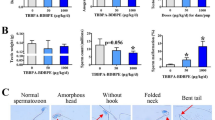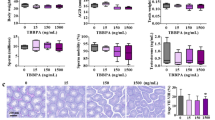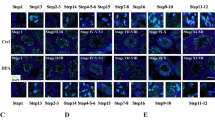Abstract
Whether environmental exposure to bisphenol A (BPA) may induce reproductive disorders is still controversial but certain studies have reported that BPA may cause meiotic abnormalities in C. elegans and female mice. However, little is known about the effect of BPA on meiosis in adult males. To determine whether BPA exposure at an environmentally relevant dose could induce meiotic abnormalities in adult male rats, we exposed 9-week-old male Wistar rats to BPA by gavage at 20 μg/kg body weight (bw)/day for 60 consecutive days. We found that BPA significantly increased the proportion of stage VII seminiferous epithelium and decreased the proportion of stage VIII. Consequently, spermiation was inhibited and spermatogenesis was disrupted. Further investigation revealed that BPA exposure delayed meiosis initiation in the early meiotic stage and induced the accumulation of chromosomal abnormalities and meiotic DNA double-strand breaks (DSBs) in the late meiotic stage. The latter event subsequently activated the phosphatidylinositol 3-kinase-related protein kinase (ATM). Our results suggest that long-term exposure to BPA may lead to continuous meiotic abnormalities and ultimately put mammalian reproductive health at risk.




Similar content being viewed by others
Abbreviations
- ATM:
-
Ataxia-telangiectasia mutated
- ATR:
-
Ataxia-telangiectasia mutated and Rad3-related
- BPA:
-
Bisphenol A
- DSBs:
-
DNA double-strand breaks
- DAPI:
-
4,6-diamidino-2-phenylindole
- MSUC:
-
Meiotic silencing of unsynapsed chromatin
- PI:
-
Propidium iodide
- PAS:
-
Periodic acid-Schiff
- SCP3:
-
Synaptonemal complex protein 3
References
Abraham RT (2001) Cell cycle checkpoint signaling through the ATM and ATR kinases. Genes Dev 15:2177–2196
Allard P, Colaiacovo MP (2010) Bisphenol A impairs the double-strand break repair machinery in the germline and causes chromosome abnormalities. Proc Natl Acad Sci USA 107:20405–20410
Blanco-Rodriguez J (2009) gammaH2AX marks the main events of the spermatogenic process. Microsc Res Tech 72:823–832
Brieno-Enriquez MA, Robles P, Camats-Tarruella N, Garcia-Cruz R, Roig I, Cabero L, Martinez F, Caldes MG (2011) Human meiotic progression and recombination are affected by Bisphenol A exposure during in vitro human oocyte development. Hum Reprod 26:2807–2818
Brieno-Enriquez MA, Reig-Viader R, Cabero L, Toran N, Martinez F, Roig I, Garcia Caldes M (2012) Gene expression is altered after bisphenol A exposure in human fetal oocytes in vitro. Mol Human Reprod 18:171–183
Brower JV, Lim CH, Jorgensen M, Oh SP, Terada N (2009) Adenine nucleotide translocase 4 deficiency leads to early meiotic arrest of murine male germ cells. Reproduction 138:463–470
Burgoyne PS, Mahadevaiah SK, Turner JM (2009) The consequences of asynapsis for mammalian meiosis. Nat Rev Genet 10:207–216
Cabaton NJ, Wadia PR, Rubin BS, Zalko D, Schaeberle CM, Askenase MH, Gadbois JL, Tharp AP, Whitt GS, Sonnenschein C, Soto AM (2011) Perinatal exposure to environmentally relevant levels of bisphenol A decreases fertility and fecundity in CD-1 mice. Environ Health Perspect 119:547–552
Chitra KC, Latchoumycandane C, Mathur PP (2003) Induction of oxidative stress by bisphenol A in the epididymal sperm of rats. Toxicology 185:119–127
Fernandez-Capetillo O, Mahadevaiah SK, Celeste A, Romanienko PJ, Camerini-Otero RD, Bonner WM, Manova K, Burgoyne P, Nussenzweig A (2003) H2AX is required for chromatin remodeling and inactivation of sex chromosomes in male mouse meiosis. Dev Cell 4:497–508
Furnari B, Blasina A, Boddy MN, McGowan CH, Russell P (1999) Cdc25 inhibited in vivo and in vitro by checkpoint kinases Cds1 and Chk1. Mol Biol Cell 10:833–845
Garagna S, Vasco C, Merico V, Esposito A, Zuccotti M, Redi CA (2005) Effects of a low dose of bentazon on spermatogenesis of mice exposed during foetal, postnatal and adult life. Toxicology 212:165–174
Herath CB, Jin W, Watanabe G, Arai K, Suzuki AK, Taya K (2004) Adverse effects of environmental toxicants, octylphenol and bisphenol A, on male reproductive functions in pubertal rats. Endocrine 25:163–172
Hess RA, Renato de Franca L (2008) Spermatogenesis and cycle of the seminiferous epithelium. Adv Exp Med Biol 636:1–15
Hochwagen A, Amon A (2006) Checking your breaks: surveillance mechanisms of meiotic recombination. Currt Biol 16:R217–R228
Howdeshell KL, Furr J, Lambright CR, Wilson VS, Ryan BC, Gray LE Jr (2008) Gestational and lactational exposure to ethinyl estradiol, but not bisphenol A, decreases androgen-dependent reproductive organ weights and epididymal sperm abundance in the male long evans hooded rat. Toxicol Sci 102:371–382
Hunt PA, Koehler KE, Susiarjo M, Hodges CA, Ilagan A, Voigt RC, Thomas S, Thomas BF, Hassold TJ (2003) Bisphenol a exposure causes meiotic aneuploidy in the female mouse. Curr Biol 13:546–553
Ichijima Y, Ichijima M, Lou Z, Nussenzweig A, Camerini-Otero RD, Chen J, Andreassen PR, Namekawa SH (2011) MDC1 directs chromosome-wide silencing of the sex chromosomes in male germ cells. Genes Dev 25:959–971
Joyce EF, Pedersen M, Tiong S, White-Brown SK, Paul A, Campbell SD, McKim KS (2011) Drosophila ATM and ATR have distinct activities in the regulation of meiotic DNA damage and repair. J Cell Biol 195:359–367
Lakind JS, Naiman DQ (2008) Bisphenol A (BPA) daily intakes in the United States: estimates from the 2003–2004 NHANES urinary BPA data. J Expo Sci Environ Epidemiol 18:608–615
Lang IA, Galloway TS, Scarlett A, Henley WE, Depledge M, Wallace RB, Melzer D (2008) Association of urinary bisphenol A concentration with medical disorders and laboratory abnormalities in adults. JAMA 300:1303–1310
Leblond CP, Clermont Y (1952) Definition of the stages of the cycle of the seminiferous epithelium in the rat. Ann NY Acad Sci 55:548–573
Lenie S, Cortvrindt R, Eichenlaub-Ritter U, Smitz J (2008) Continuous exposure to bisphenol A during in vitro follicular development induces meiotic abnormalities. Mutat Res 651:71–81
Li DK, Zhou Z, Miao M, He Y, Wang J, Ferber J, Herrinton LJ, Gao E, Yuan W (2011) Urine bisphenol-A (BPA) level in relation to semen quality. Fertil Steril 95(625–630):e621–e624
Lie PP, Cheng CY, Mruk DD (2009) Coordinating cellular events during spermatogenesis: a biochemical model. Trends Biochem Sci 34:366–373
Longhese MP, Bonetti D, Guerini I, Manfrini N, Clerici M (2009) DNA double-strand breaks in meiosis: checking their formation, processing and repair. DNA Repair 8:1127–1138
Mahadevaiah SK, Turner JM, Baudat F, Rogakou EP, de Boer P, Blanco-Rodriguez J, Jasin M, Keeney S, Bonner WM, Burgoyne PS (2001) Recombinational DNA double-strand breaks in mice precede synapsis. Nat Genet 27:271–276
Meeker JD, Ehrlich S, Toth TL, Wright DL, Calafat AM, Trisini AT, Ye X, Hauser R (2010) Semen quality and sperm DNA damage in relation to urinary bisphenol A among men from an infertility clinic. Reprod Toxicol 30:532–539
Nickerson HD, Joshi A, Wolgemuth DJ (2007) Cyclin A1-deficient mice lack histone H3 serine 10 phosphorylation and exhibit altered aurora B dynamics in late prophase of male meiosis. Dev Biol 306:725–735
Nojima H (2006) Protein kinases that regulate chromosome stability and their downstream targets. Genome Dyn 1:131–148
Peters AH, Plug AW, van Vugt MJ, de Boer P (1997) A drying-down technique for the spreading of mammalian meiocytes from the male and female germline. Chromosom Res 5:66–68
Quignot N, Arnaud M, Robidel F, Lecomte A, Tournier M, Cren-Olive C, Barouki R, Lemazurier E (2012) Characterization of endocrine-disrupting chemicals based on hormonal balance disruption in male and female adult rats. Reprod Toxicol 33:339–352
Rubio J, Riqueros MI, Gasco M, Yucra S, Miranda S, Gonzales GF (2006) Lepidium meyenii (Maca) reversed the lead acetate induced – damage on reproductive function in male rats. Food Chem Toxicol 44:1114–1122
Ryan BC, Hotchkiss AK, Crofton KM, Gray LE Jr (2010) In utero and lactational exposure to bisphenol A, in contrast to ethinyl estradiol, does not alter sexually dimorphic behavior, puberty, fertility, and anatomy of female LE rats. Toxicol Sci 114:133–148
Salian S, Doshi T, Vanage G (2009) Neonatal exposure of male rats to Bisphenol A impairs fertility and expression of sertoli cell junctional proteins in the testis. Toxicology 265:56–67
Sasaki M, Lange J, Keeney S (2010) Genome destabilization by homologous recombination in the germ line. Nat Rev Mol Cell Biol 11:182–195
Souter I. DI, Smith K, Ehrlich S, Berry K, Hauser R (2011) Urinary bisphenol A (BPA) concentrations and ovarian reserve in women undergoing infertility treatments. Human Reprod 26 Suppl:1(i6)
Susiarjo M, Hassold TJ, Freeman E, Hunt PA (2007) Bisphenol A exposure in utero disrupts early oogenesis in the mouse. PLoS Genet 3:e5
Ulutas OK, Yildiz N, Durmaz E, Ahbab MA, Barlas N, Cok I (2011) An in vivo assessment of the genotoxic potential of bisphenol A and 4-tert-octylphenol in rats. Arch Toxicol 85:995–1001
Vandenberg LN, Chahoud I, Heindel JJ, Padmanabhan V, Paumgartten FJR, Schoenfelder G (2010) Urinary, circulating, and tissue biomonitoring studies indicate widespread exposure to bisphenol A. Environ Heal Perspect 118:1055–1070
Wu HJ, Liu C, Duan WX, Xu SC, He MD, Chen CH, Wang Y, Zhou Z, Yu ZP, Zhang L, Chen Y (2013) Melatonin ameliorates bisphenol A-induced DNA damage in the germ cells of adult male rats. Mutat Res (in press)
Acknowledgments
We thank Ms. Min Li and Mr. Ju Yang for their skillful technical assistance. This work was supported by the National Basic Research Program of China (National 973 Program; Grant No. 2011CB503700) and the National Natural Science Foundation of China (Grant No. 31170800).
Conflict of interest
The authors declare no conflict of interest.
Author information
Authors and Affiliations
Corresponding author
Rights and permissions
About this article
Cite this article
Liu, C., Duan, W., Zhang, L. et al. Bisphenol A exposure at an environmentally relevant dose induces meiotic abnormalities in adult male rats. Cell Tissue Res 355, 223–232 (2014). https://doi.org/10.1007/s00441-013-1723-6
Received:
Accepted:
Published:
Issue Date:
DOI: https://doi.org/10.1007/s00441-013-1723-6




